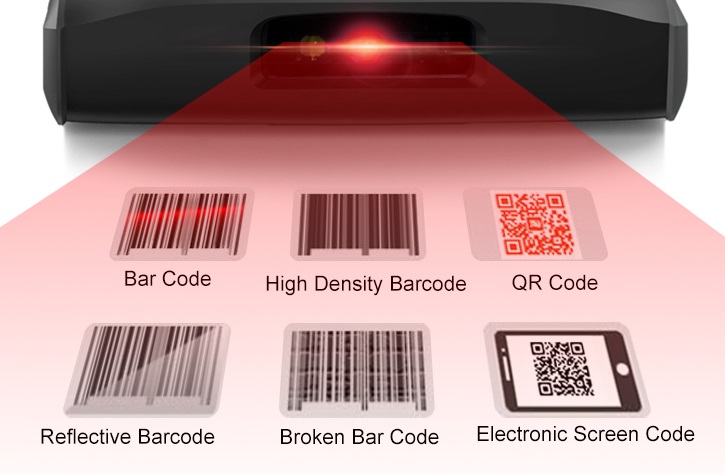Scanning terminals
FAQ about scanning & terminals

1D Barcode
| A 1D barcode (also known as a linear code) is a visual black and white pattern, using variable-width lines and spaces for encoding information. That information – typicaly numbers and alpha characters - are encoded horizontally from left to right. 1D barcodes holds a limited number of characters, typically 10-25. The most familiar 1D barcodes are those common UPC codes found on grocery and consumer items. Also Code128(A/B) are used very often in industries and warehousing. A 1D barcode strictly depends on on-line database connectivity in order to be meaningful: after a scanner reads the numbers in the code, this code must be linked with database, where is full desctiption of this product, whole batch of his parameters, price, actual stock value and other information. |
2D barcode
| A 2D barcode uses patterns, shapes, and dots to encrypt information both horizontally and vertically. 2D barcode can encrypt more characters (around 2000) in the same amount of space as a 1D barcode (which only has 10-25). Types of 2D codes include QR code, PDF417, and Data Matrix. In addition to holding more data, 2D barcodes can encrypt images, website addresses, and other binary data, which means that the codes can work independently of a database. 2D barcodes can be used to mark very small items where a traditional barcode label will not fit. When it comes to customer selection, 2D barcodes are often people’s preference due to the amount of information a 2D barcode can hold in comparison to a 1D. |
OPERATIONAL AND FUNCTIONAL DIFFERENCES BETWEEN THE 1D AND 2D BARCODE
| Operationally, the critical difference between the two types of barcodes is in the type of scanning engine required to read them. (See the next question for more). Functionally, which type of code is used will depend on the application. Linear (1D) codes tend to be used in scenarios where the associated data is prone to changing frequently (i.e., pricing or the contents of a container). 2D barcodes are used where there may not be database connectivity, where space is limited, and where larger amounts of data are required. Most companies use a variety of different codes for different applications. Think about a typical shipping label or package. This will reveal as many as a half-dozen different types of barcodes on a single box. Again, 2D barcodes tend to be popular due to the amount of information one can hold. Knowing the capabilities (and limitations) of both 1D and 2D barcodes allows you to make the best decision for your enterprise. |
LASER SCANNER OR IMAGE READER
| There are two different scan engine types (laser scanner versus imager) for interpreting the information provided in the barcode. Many companies producing the technology capable of reading the barcode data uses the term “scanning” regardless of the type of scan engine used. Linear (1D) codes can be scanned with a traditional laser scanner. --A laser scan engine uses a laser and mirror to create the bar that scans the information. 1D barcode scanners will only interpret the linear barcode scanning technology. 1D barcode scanners are typically less expensive since the type of encryptions they can decode is limited. A laser scan engine comes in standard range or long range. --2D barcodes must be read using a scan engine type known as an imager. Imagers come in two types – 1D only and 1D/2D. There are subsets of each: standard range, medium range or near/far. 2D barcode imagers can read both linear and two-dimensional barcodes. 2D imagers have become so versatile that they often are replacing 1D barcode scanners in many applications. |
